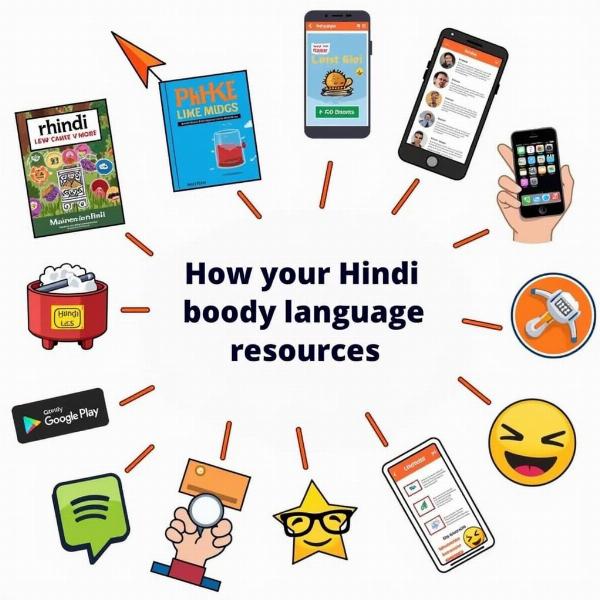Understanding the nuances of Hindi, especially the surprising meanings words can take on, is crucial for accurate communication. A seemingly simple word can have a completely different meaning depending on context, regional dialect, or even tone of voice. This can lead to misunderstandings, especially for those new to the language. Learning these surprising meanings not only improves your language skills but also provides a deeper appreciation for the richness and complexity of Hindi. Delving into the “surprising meaning in Hindi” opens a window into the cultural nuances and historical influences that have shaped this vibrant language.
Unveiling the Unexpected: Surprising Meanings in Hindi Words
Hindi, like any language, is full of words that can surprise you with their multiple meanings. This is particularly true when considering regional variations and colloquialisms. For instance, the word “kal” can mean both “yesterday” and “tomorrow”, leading to potential confusion if the context isn’t clear. Another example is the word “acha”, which can mean “good”, “okay”, or even be used as a filler word similar to “um” in English.
Context is Key: Deciphering Surprising Meanings
The key to understanding these surprising meanings lies in the context. Pay close attention to the surrounding words, the situation, and the speaker’s tone of voice. These clues will often help you decipher the intended meaning. For example, if someone says “kal milte hain,” (we’ll meet tomorrow), the future tense verb “milte hain” clarifies that “kal” refers to “tomorrow”.
Regional Variations and Colloquialisms: Adding to the Surprise
Regional variations and colloquialisms further contribute to the surprising meanings of Hindi words. A word that means one thing in one part of India might have a completely different meaning in another. Similarly, informal slang can add layers of meaning that might be missed by someone unfamiliar with the local dialect. This is why immersion and interaction with native speakers are invaluable for truly grasping the nuances of the language. duct tape meaning in hindi Understanding these regional and colloquial variations is crucial for accurate interpretation.
Commonly Misunderstood Words: Examples of Surprising Meanings
Several commonly used Hindi words have surprising meanings that often trip up learners. “Didi,” typically meaning “elder sister,” can also be used respectfully to address any older woman. Similarly, “bhaiya,” meaning “elder brother,” can be used for any older male. These terms demonstrate the respect embedded within Hindi culture. quite a few meaning in hindi Learning these common pitfalls can significantly improve your communication skills.
Embracing the Challenge: Tips for Mastering Surprising Meanings
Mastering these surprising meanings requires active listening, continuous learning, and a willingness to embrace the complexities of the language. Don’t be afraid to ask for clarification when you encounter unfamiliar words or phrases. Immerse yourself in Hindi media, interact with native speakers, and use language learning resources to expand your vocabulary and understanding.  Mastering the Nuances of Hindi meaning of bran in hindi The more you engage with the language, the better you’ll become at navigating its surprising twists and turns.
Mastering the Nuances of Hindi meaning of bran in hindi The more you engage with the language, the better you’ll become at navigating its surprising twists and turns.
Conclusion: Appreciating the Richness of Surprising Meaning in Hindi
The surprising meanings within Hindi add to the richness and depth of the language. While they can present a challenge for learners, they also offer a fascinating glimpse into the cultural and historical influences that have shaped this vibrant language. Embrace the challenge, and you’ll be rewarded with a deeper understanding and appreciation for the beauty of Hindi. crush the bottle after use meaning in hindi By exploring the “surprising meaning in Hindi”, you unlock a deeper understanding of Indian culture and communication.
FAQ:
- Why does Hindi have so many words with multiple meanings? Like many languages, Hindi’s evolution has led to words acquiring multiple meanings over time, influenced by regional dialects and cultural contexts.
- How can I avoid misunderstandings due to these surprising meanings? Pay close attention to context, ask for clarification when needed, and immerse yourself in the language to better understand its nuances.
- Are there any resources that can help me learn these surprising meanings? Yes, dictionaries, online resources, and language learning apps often provide detailed explanations of word meanings and usage.
- Is it important to learn regional variations of Hindi words? While not essential for basic communication, understanding regional variations can greatly enhance your comprehension and cultural sensitivity.
- What’s the best way to improve my understanding of Hindi nuances? Regular interaction with native speakers, immersion in Hindi media, and consistent study are crucial for mastering the intricacies of the language.
- How can I differentiate between the different meanings of a word? Context, tone of voice, and surrounding words are key indicators of the intended meaning.
- Are there any common mistakes learners make with surprising meanings in Hindi? Yes, misunderstanding words like “kal,” “acha,” “didi,” and “bhaiya” are common errors among learners.
Meaning-Hindi.in is your trusted partner for professional Hindi translation services. We specialize in various domains, including business, legal, technical, website localization, educational, and specialized content. Our expert linguists ensure accurate and culturally sensitive translations, bridging the communication gap between languages and cultures. padri meaning in hindi For all your Hindi translation needs, contact us at [email protected] or call us at +91 11-4502-7584. Meaning-Hindi.in is here to help you connect with the Hindi-speaking world.